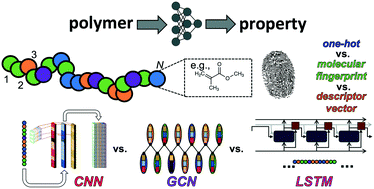Featurization strategies for polymer sequence or composition design by machine learning†
Abstract
The emergence of data-intensive scientific discovery and machine learning has dramatically changed the way in which scientists and engineers approach materials design. Nevertheless, for designing macromolecules or polymers, one limitation is the lack of appropriate methods or standards for converting systems into chemically informed, machine-readable representations. This featurization process is critical to building predictive models that can guide polymer discovery. Although standard molecular featurization techniques have been deployed on homopolymers, such approaches capture neither the multiscale nature nor topological complexity of copolymers, and they have limited application to systems that cannot be characterized by a single repeat unit. Herein, we present, evaluate, and analyze a series of featurization strategies suitable for copolymer systems. These strategies are systematically examined in diverse prediction tasks sourced from four distinct datasets that enable understanding of how featurization can impact copolymer property prediction. Based on this comparative analysis, we suggest directly encoding polymer size in polymer representations when possible, adopting topological descriptors or convolutional neural networks when the precise polymer sequence is known, and using chemically informed unit representations when developing extrapolative models. These results provide guidance and future directions regarding polymer featurization for copolymer design by machine learning.

- This article is part of the themed collections: Machine Learning and Artificial Intelligence: A cross-journal collection and Emerging Investigator Series


 Please wait while we load your content...
Please wait while we load your content...